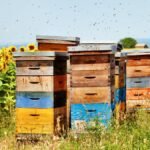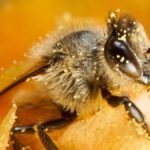“How many bee hives per acre?” This is one of the most frequently asked questions, often followed by “how much honey can each hive produce?” While there’s no one-size-fits-all answer to either, we can examine various factors to estimate the optimal hive density. Understanding the geography of your land and the available floral resources is key. Tools like Google Maps can be incredibly useful in evaluating the area. Let’s dive into some important considerations to help determine your land’s bee-carrying capacity, starting with a few essential bee foraging facts.
How Far Can A Bee Forage?
There is no real accurate answer to this question, as this varies from race to race. It is generally accepted that the range of a bee is about 3.5-4 miles from the hive. I personally think this number may be a bit higher for African bees as I once kept an apiary on a very remote site, and there was a Eucalyptus tree plantation 6 miles as the crow flies from the hives. When these trees were flowering, the bees made, rather ironically, a beeline straight for these trees. You could literally see the line of bees flying to the Eucalyptus trees on the horizon.

Learn more about: When Do Bees Go Away?
How Far Can A Bee Fly-In Its Life?
A honeybee is just like a vehicle – it carries things from point A to B, and in so doing will incur wear and tear. The further a bee flies to the flowers and back, the fewer loads it can carry. Ideally for a bee, the best is if it can hop out of the hive – fly 50 yards, collect nectar, and return. This way the bees can perform thousands of flights in their short life. This also influences how many beehives per acre. We do not want to force them to fly too far.
What Determines How Many Hives Per Acre?
Bees collect nectar and pollen from flowers. This is used to maintain the hive and produce more bees, wax, and stores of honey. Bees, much like us, thrive on a varied diet. This is especially the case for pollen – the more types of pollen they can collect, the happier and healthier the hive will be. How many bee hives per acre we stock influences the amount of pollen available.
Nectar is a resource, and bees collect this from flowers. The number of bees divided by the number of flowers is essentially your carrying capacity. There is no real way to work this out yet today. Flowers also vary seasonally and depending on climate. I have had bees in the same apiary produce entirely different tasting honey at the same month in consecutive years based on what flowered.
We also find that apiaries become acclimatized to an area. I have noticed with hives where I allow the queens to mate and requeen without interference that the bees seem to become adapted to an area. The honey yield increases in the same site year on year as the bees adapt. There is also probably an effect where strong hives populate drone congregations areas and this yields better and better hives each year. In this regard, I have noticed that as an apiary adapts to an area, the number of hives can be increased.
Google Maps Survey
My first trick is always to do a Google maps survey of the site. That satellite view helps you see if there are hidden flower resources in the area. I once had an apiary site that was in a bland grassy field. However, a half a mile away, in a hidden valley, there was an old abandoned citrus orchard consisting of about twenty acres of trees. These unmanaged trees flowered like crazy for about three months a year, as they were Eureka lemons. The Google Maps survey revealed this nectar source. A cursory look at the apiary site however would have caused me to not stock the site.
If you go to Google Maps, find your potential apiary site, and then use the ruler function to measure off a circle 3 miles around the site. Have a look at this for fields, forests, meadows, towns, etc. Towns are a great source of nectar as there are usually a lot of species of flowering plants in towns. These provide pollen of varied diet, which helps hives resist disease. It has been shown that bees with a polyfloral pollen diet are more resistant to Nosema ceranae for example.
Beware of landfill sites – I try to keep apiaries away from these. Bees will collect leftover cooldrink and soda from landfill sites. They will also clean out old bottles of honey, which can contain spores of diseases. I once knew a beekeeper who used to take his hives to landfill sites near LA just before spring to feed them up on “free sugar”. This is just a bit gross actually.
How Many Hives Per Acre?
When you have strong natural honey flows such as clover, goldenrod, dandelion, various forests, and the like, you will easily be able to stock your hives at quite high densities. If we look at the foraging range of a hive, it means a hive covers an area of approximately 4500 acres. Generally, the rule of thumb is a density of 1 – 3 hives per acre for pollination, hence an apiary site can hold a lot of bees.
Law Of Diminishing Returns
We find that as with any extractive process, beekeeping experiences the law of diminishing returns. You will find that as you increase the number of hives in an apiary, you reach a ceiling after which the productivity per hive begins to decline. You will also notice that if you have too many honeybee hives on a site that they can start robbing each other during dry spells. High numbers of bees can also attract pests such as yellow jackets, bears, and human thieves.
The Law Of Diminishing Returns Gets Broken
When we heavily stock an apiary we ensure that all flowering plants in the area are hyper-pollinated. This means that they produce more seeds. If this is a wildflower meadow, we will consequently shift the balance of the meadow from grasses (which are wind-pollinated) to nectar flowers (which are bee-pollinated).
I have seen in apiaries over the years that we will tend to find that the bees select for plants that benefit them, and over time, the carrying capacity and nectar density of an area increases. This means that we actually break the law of diminishing returns as the bee carrying capacity increases. In this regard, you often find that you may have an apiary where the maximum number of hives you can keep is about 50, and then after three years, you find you can increase this to 80 or even 100 hives.
The Ultimate Best ratio of Bee Hives Per Acre
There is no real rule as to how many bees per acre – although suggestions are 1-3 hives for pollination. For honey production, it is really just a case of stocking your apiary until you get a drop in production. You then ease back for a few years and then increase numbers as your ecosystem adapts to the presence of the bees.
Google Maps can help you get a good aerial view of your area as can a drone (the one that you fly, not the male honeybee).
We hope this article has helped you understand how to work out the maximum beehives per acre – and see that this is a very flexible number that you can change to your benefit. Keep bees to keep more bees. Win-win situation. Share if you enjoyed it. Let us get that bee-carrying capacity up all over our world and make the ecosystem strong.
Read more about: How Much Do Beehives Cost?
FAQs
How many bee hives can I have per acre?
Generally, you can have between 1-3 bee hives per acre for pollination purposes. However, this depends on the availability of forage, climate, and the health of the local ecosystem.
What factors determine how many bee hives can be placed per acre?
The number of hives per acre depends on nectar and pollen availability, forage density, and the types of flowers in the area. Overcrowding hives can lead to reduced honey production and unhealthy competition.
Can I increase the number of bee hives on my land over time?
Yes. As bees pollinate the area, wildflower populations can grow, increasing the nectar availability. This may allow you to add more hives in the future.
How far can bees forage from the hive?
Bees can forage up to 3-4 miles from the hive, covering an area of about 4,500 acres. This means that they can gather nectar from a wide range of plants even beyond your property.
What is the law of diminishing returns in beekeeping?
As you add more hives to an area, the productivity of each hive can decrease due to limited forage. If too many hives compete for the same resources, honey yields can drop.
How does forage variety impact how many hives I can have?
A diverse range of plants provides bees with varied pollen and nectar sources, which improves hive health. This diversity supports higher hive densities on your land.
How can I use Google Maps to plan the number of hives per acre?
Google Maps can help identify nearby nectar sources like fields, forests, or urban areas that could support your hives. This aerial survey can give you a better estimate of the carrying capacity of the land.
What happens if I overstock bee hives on my land?
Overstocking can lead to bees robbing each other’s hives during nectar shortages, increased pest issues, and reduced honey yields. It’s important to balance hive numbers with available forage.
Does the local environment affect how many bee hives I can keep?
Yes. Factors like weather, soil type, and nearby agricultural practices can impact the availability of nectar and pollen, which will influence how many hives can be supported per acre.
Note: Always check with your local clubs or regulating bodies to ensure you are within your legal limits for hives. Just because the environment can handle additional beehives, you may be breaching your regulations by adding additional hives so best to check.

Dr. Garth A. Cambray is a Canadian/South African entrepreneur and beekeeper with 28 years of experience in apiculture and specializes in adding value to honey. His Ph.D. research developed a new advanced continuous fermentation method for making mead that has resulted in a number of companies globally being able to access markets for mead. His company, Makana Meadery, exports honey mead to the USA where it is available to discerning connoisseurs. He has also developed technologies to commercially manufacture organic honey vinegar in Zambia for export globally. He holds a few patents globally in the ethanol industry and believes in technology and knowledge transfer for human development and environmental sustainability. One of his proudest achievements is the fact that the wind farm he started at one of his old apiary sites has essentially made his hometown carbon neutral.






